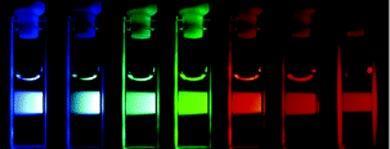Carbon could soon replace cadmium as the material of choice for quantum dots, claim scientists in the US
Carbon could soon replace cadmium as the material of choice for quantum dots, following the development of fluorescent carbon nanoparticles by scientists in the US.
Quantum dots are semiconductor nanocrystals that can fluoresce at wavelengths in the visible spectrum. This property has allowed a number of potential applications to be investigated, including biological labelling. The main problem is that the current generation of quantum dots are based on metallic elements, such as cadmium, that pose risks to human health and the environment.

Quantum dots based on carbon should be much safer, but carbon nanoparticles are not naturally fluorescent. ’Carbon is hardly considered to be a semiconductor, so luminescent carbon nanoparticles are very interesting both fundamentally and practically,’ explains lead researcher Ya-Ping Sun from Clemson University, South Carolina.
Sun and his colleagues found that they could make carbon nanoparticles fluoresce when exposed to light by simply attaching polymer strands to their surfaces. This worked with the polymers poly(ethylene glycol) and poly(propionylethyleneimine-co-ethyleneimine).
The polymers stabilised the surface of the carbon nanoparticles, which were on average around 5 nm long. This helped to generate energy traps on the nanoparticle surfaces and these traps emitted light when stimulated.
The polymer coating also allows the researchers to attach antibodies or other biomolecules to the carbon dots, and Sun and colleagues have already shown that the dots can be used to image bacterial cells and spores.
’This is an exciting discovery,’ said John de Mello, a lecturer in nanomaterials at Imperial College London, UK, but he suggested the researchers should work on their production process. ’Improved synthesis procedures are likely to be needed in future in order to achieve better control of the size, shape and physical properties of the particles,’ he told Chemistry World.
Jon Evans
References
et alJ. Am. Chem. Soc. (DOI: 10.1021/ja062677d)






No comments yet